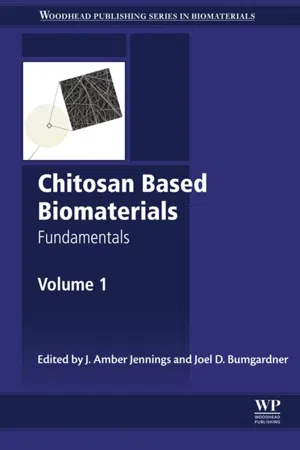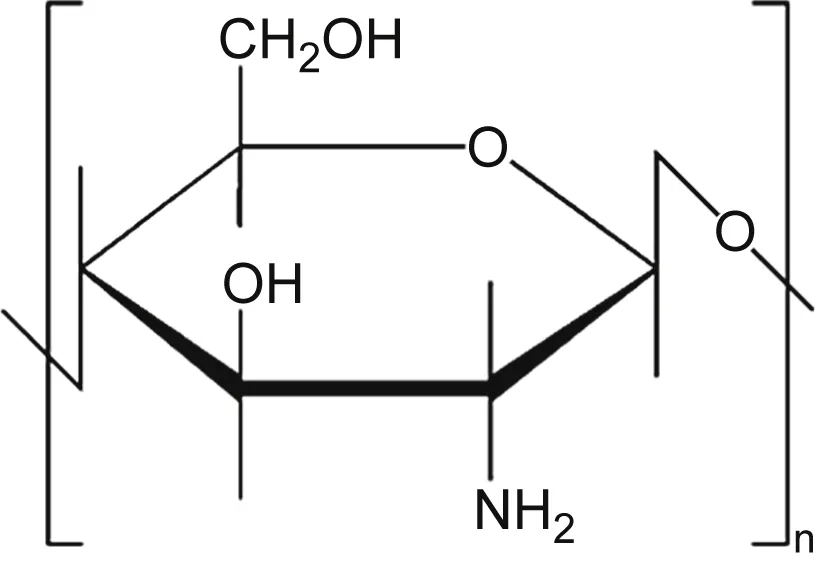
eBook - ePub
Chitosan Based Biomaterials Volume 1
Fundamentals
This is a test
- 342 pages
- English
- ePUB (mobile friendly)
- Available on iOS & Android
eBook - ePub
Book details
Book preview
Table of contents
Citations
About This Book
Chitosan Based Biomaterials: Fundamentals, Volume 1, provides the latest information on chitosan, a natural polymer derived from the marine material chitin. Chitosan displays unique properties, most notably biocompatibility and biodegradability. It can also be easily tuned to modify its structure or properties, making chitosan an excellent candidate as a biomaterial. Consequently, chitosan is being developed for many biomedical functions, ranging from tissue engineering and implant coatings to drug and gene delivery. This book looks at the fundamentals of chitosan-based biomaterials.
- Contains specific focus on the techniques and technologies needed to develop chitosan for biomedical applications
- Presents a comprehensive treatment of the fundamentals
- Provides contributions from leading researchers with extensive experience in chitosan
Frequently asked questions
At the moment all of our mobile-responsive ePub books are available to download via the app. Most of our PDFs are also available to download and we're working on making the final remaining ones downloadable now. Learn more here.
Both plans give you full access to the library and all of Perlego’s features. The only differences are the price and subscription period: With the annual plan you’ll save around 30% compared to 12 months on the monthly plan.
We are an online textbook subscription service, where you can get access to an entire online library for less than the price of a single book per month. With over 1 million books across 1000+ topics, we’ve got you covered! Learn more here.
Look out for the read-aloud symbol on your next book to see if you can listen to it. The read-aloud tool reads text aloud for you, highlighting the text as it is being read. You can pause it, speed it up and slow it down. Learn more here.
Yes, you can access Chitosan Based Biomaterials Volume 1 by Jessica Amber Jennings,Joel David Bumgardner in PDF and/or ePUB format, as well as other popular books in Technology & Engineering & Materials Science. We have over one million books available in our catalogue for you to explore.
Information
Part One
Fundamentals of chitosan for biomedical applications
1
Fundamentals of chitosan for biomedical applications
E. Vunain, A.K. Mishra, and B.B. Mamba University of South Africa, Johannesburg, South Africa
Abstract
Biomaterials have been successfully developed and applied in implanted biomedical devices. Natural polymers are readily accepted by the body and possess high bioactivity and biocompatibility. Chitosan, a copolymer of glucosamine and N-acetyl glucosamine, is among the most abundant biopolymers on earth and has been used in a wide range of biomedical applications. Chitosan, a polycationic polymer is comprised of different functional groups that can be modified with a range of ligands. The unique physicochemical properties offer chitosan great potential in a range of biomedical applications such as tissue engineering, drug delivery vehicles, and enzyme immobilization for biosensing. This chapter focuses on the fundamental uses of chitosan in a variety of biomedical applications.
Keywords
5-fluorouracil; Asialoglycoprotein; Biosensors; Carboxymethylchitosan; Chemical modification; Chitosan; Degree of deacetylation; Drug delivery; Rhizopus stolonifer; Tissue engineering
1.1. Introduction
Chitosan is a natural polysaccharide obtained from partial or full deacetylation of chitin (Hu et al., 2015; Thein-Han and Misra, 2009). Chitin, the source material for chitosan, is the most naturally abundant polysaccharide after cellulose (Dutta et al., 2004). Chitin is an important component of the cell wall of fungi, the exoskeleton of crustaceans, and insects. Chitosan is the N-deacetylated derivative of chitin, a linear and semicrystalline polysaccharide composed of glucosamine and N-acetyl glucosamine units linked by β-(1→4) glycosidic bonds (Rinaudo, 2006) (Fig. 1.1). When the fraction of glucosamine units is greater than 50%, the polymer is commonly called chitosan and the number of glucosamine units is termed degree of deacetylation (DDA). Chitin, on the other hand, is the term when the N-acetyl glucosamine units are greater than 50% and the number of acetamido groups is termed the degree of acetylation (DA). Mathematically, DA = 1 − DDA (Dornish et al., 2001; VandeVord et al., 2002). It should be noted here that when the DDA of chitin reaches about 50% or greater (depending on the origin of the polymer and processing conditions), it becomes soluble in aqueous acidic media.
Chitosan is insoluble in aqueous solution above pH 7, in its crystalline form. However, in dilute acids (pH < 6), the protonated free amino groups on glucosamine facilitate solubility of the polymeric molecule (Madihally and Matthew, 1999). In acidic media, the polysaccharide is converted into a polyelectrolyte. A polyelectrolyte is a polymer carrying either positively or negatively charged ionizable groups. Solubilization occurs by protonation of the –NH2 group on the C-2 position of the D-glucosamine repeat unit. Chitosan is the second most abundant natural biopolymer after cellulose in terms of availability to the extent of over 10 gigatons (1 × 1013) annually (Harish Prashanth and Tharanathan, 2007). Chitosan is a nontoxic, biodegradable polymer of high molecular weight and very similar to cellulose, a plant fiber. Depending on the source and preparation procedure, its molecular weight may range from 300 to over 1000 kDa with a DDA from 30% to 95%, though by convention, only polymers with greater than 50% DDA are referred to as chitosan. The functional properties of chitosan such as film formation, antimicrobial activity, and use as a thickening agent are related to its molecular weight and DDA. These two parameters are very important because they affect the potential applications on chitosans in various fields. For example, low molecular weight chitosan has low viscosity, which limits its applications, and oligomers of chitosan do not form films. Furthermore, the antimicrobial effect of chitosan is stronger if the molecular weight is greater than 100 kDa and has high DDA (No et al., 2002; Zheng and Zhu, 2003) (see Chapters 5 and 6 regarding changing DDA and MW). Additionally, chitosan is highly amenable to chemical modification via one of its three reactive functional groups: the amino group as well as both primary and secondary hydroxyl groups on C(2), C(3), and C(6) respectively (Fig. 1.1).

Figure 1.1 Molecular structure of chitosan polymer.
The presence of these functional groups allows for easy modification of the chitosan to attach molecules through procedures such as graft polymerization for specific applications. Furthermore, chitosan offers several advantages in biomedical applications, such as biocompatibility, biodegradability (Kenawy et al., 2015; Kumar et al., 2004), and that degradation products do not produce inflammatory reactions or toxic degradation products (i.e., its degradability products are nontoxic, noncarcinogenic, and nonimmunogenic) (Swetha et al., 2010). Due to its unique polycationic nature, controlled biodegradability, biocompatibility, nontoxicity, and bioresorbable nature, chitosan has wide application in medical fields for applications such as gene therapy (drug or gene delivery), wound dressing, tissue engineering, blood anticoagulant, hypocholesterolemic agents, antithrombogenic agents, bone regeneration biomaterials, and antimicrobial agents (Agnihotri et al., 2004; Danielsen et al., 2005; Di Martino et al., 2005; Ishihara et al., 2002; VandeVord et al., 2002). In addition, chitosan has been used in other industrial fields such as cosmetic preparations, paper and pulp, wastewater treatment, and food and feed additives (Balicka-Ramisz et al., 2007; Struszczyk et al., 2002).
Chitosan is a white to light red solid powder depending on processing conditions and levels of residual pigments. Its physiological functions include decreasing cholesterol, decreasing high blood pressure, inhibition of fat a...
Table of contents
- Cover image
- Title page
- Table of Contents
- Related titles
- Copyright
- List of contributors
- Woodhead Publishing Series in Biomaterials
- Part One. Fundamentals of chitosan for biomedical applications
- Part Two. Chemical and physical modification of chitosan-based biomaterials
- Part Three. Production techniques for chitosan-based biomaterials
- Index